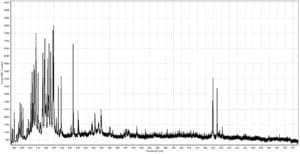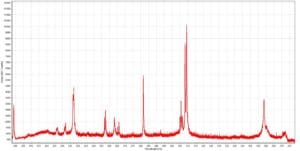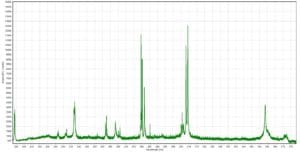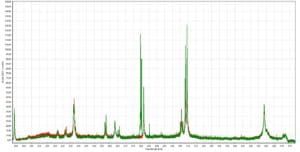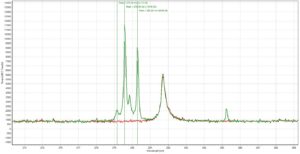Aluminum Metal Identification with Portable LIBS Instrument
The metal sorting industry relies heavily on metal identification methods such as LIBS to sort metal. Metals, such as Aluminum 1100 and Aluminum 6063 can be challenging to identify without LIBS. In this experiment, we will test several types of metal and identify them based on their spectral lines.
Laser Induced Breakdown Spectroscopy (LIBS) is a type of atomic emission spectroscopy which uses a highly energetic laser pulse as the excitation source. The laser is focused to form a plasma, which atomizes and excites samples. The formation of plasma begins when the focused laser achieves a certain threshold for optical breakdown. This can be performed on any state of matter as all elements emit light of characteristic frequencies when excited to sufficiently high temperatures.
Conducted by: David Ademe, Avantes Inc.
System Description
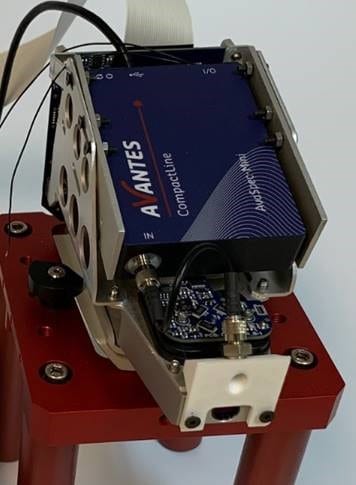
Figure 1: Portable Libs Test Kit
The setup for this experiment incorporates the Falcon Laser, courtesy of Lumibird, and the Avantes AvaSpec-Mini spectrometer into a single, compact package. The spectrometer is mounted directly to the laser, with a short fiber connected to the Mini, with the receiving end lined up with the focal point of the laser to acquire LIBS spectra. The AvaSpec-Mini used in this experiment is optimized for the UV range.
The new generation, our AvaSpec-Mini MK-II series (AvaSpec-Mini2048CL and AvaSpec-Mini4096CL) is definitely one of the smallest types of spectrometers on the market today. In cases where size matters, the AvaSpec CompactLine family offers spectrometers with the smallest form factor. This enables easier integration of our spectrometers into machines and handheld devices. Squeezing down the size hardly compromises the performance of the instruments, but limits the customer a bit in the number of possible configurations. Customization is possible when adequate volumes are needed. This makes the CompactLine especially suited for OEM users wanting to integrate a spectrometer into their own devices. The AvaSpec-Mini-CL series can be equipped with a 2048 pixel CMOS detector or our first-to-the-market 4096-pixel array. Enjoy the speed and enhanced native UV/NIR response of CMOS with an incredible resolution of up to 0.09 nm unavailable anywhere else. The low stray light design allows stray light levels from as low as 0.2% and the fast response time boasts data transfer speeds as fast as 4.6 ms/scan and integration times ranging from 30 µs to 50 s.
From Lumibird, the Falcon laser series was built for rugged applications and unpredictable environments where temperature and vibration would destroy most commercial lasers. A proprietary design, the Falcon provides eye-safe wavelengths in a compact yet robust package. Designed for battery operation in hand-held and mobile applications, this DPSS Nd:YAG laser features maintenance free operation for years of hard use.
Metal Identification Methodology
For this experiment, the spectrometer was mounted to the laser. Using serial commands, we were successfully able to fire the laser. Once the laser began firing, data was collected through the LIBS module in AvaSoft. The LIBS module allows the user to configure a number of settings, such as the ability to sync the spectrometer scans with the laser pulses.
Test Data and Results
The following images show the metal identification LIBS data from the samples that were tested: AL 1100, AL 6063 and Copper.
Figure 2: The collected LIBS spectrum of Copper, Figure 3: The collected LIBS spectra of AL 1100,
Figure 4: The collected LIBS spectra of AL 6063.
Aluminum Identification Analysis
Comparing the collected data with a known LIBS database, these samples are emitting spectra as expected. One of the defining traits of differentiating AL 1100 and AL 6063 is the magnesium peak, which can not be done in x-ray methods of identification. These magnesium peaks can be found between 279 nm and 280 nm in AL 6063, but not AL 1100. As the following screenshot displays, these peaks do appear when comparing our AL 1100 and AL 6063 spectra.
Figure 5, 6: Comparison of the AL 1100 and AL 6063 samples.
Conclusion
The AvaSpec-Mini, in combination with the Falcon Laser, provide an excellent package for handheld LIBS applications, capable of obtaining extremely accurate and reliable data. If you would like to demo the setup or have your samples tested to see how the setup can benefit your LIBS applications, please contact your Avantes representative.
 My Cart
My Cart 
